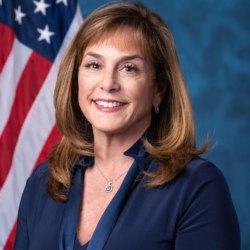Q&A: Optimizing the financing and regulation of the U.S. economy
The following is a recent discussion between U.S. Congresswoman Lisa C. McClain, Northwood University Provost Kristin Stehouwer and Dr. Timothy G. Nash, director of the McNair Center for the Advancement of Free Enterprise and Entrepreneurship at Northwood University.
McClain: The majority of my role so far representing Michigan’s 10th Congressional District is the financing of government and the regulation of the economy.
There are four ways to finance government. Taxation, borrowing, inflation and the leasing and/or sale of government assets (i.e. sale or lease of land, lumber, mineral, oil and/or natural gas rights, etc.).
There are numerous ways we set rules to regulate the economy. Some examples include the environment in which business and agriculture should be conducted; how public schools should be organized; and how the environment should be protected.
Today, I have five questions centered on the previously noted responsibilities of a member of the United States Congress.
Tim, let’s start with you. Many Americans and a significant number of politicians feel the rich do not pay their fair share in taxes. Do you agree?
Nash: No, I do not agree. Finalized data from the IRS and the Tax Foundation reveal individual income tax returns for 2019 show taxpayers filed 148.3 million tax returns, reported earnings of nearly $11.9 trillion in adjusted gross income and paid $1.6 trillion in individual income taxes to the government. The top 1% paid a 25.6% average individual income tax rate, which is more than seven times higher than taxpayers in the bottom 50%, which was 3.5%. The top 1% earned 20.1% of all individual income (just over $612 billion) and paid 38.8% of all the individual income taxes. The top 5% earned 35.9% of all the individual income and paid 59.4% of all individual income taxes. The top 10% earned 47.3% of all individual income, and paid 70.8% of all individual income taxes. Finally, the bottom 50% earned 11.5% of total national income and paid 3.1% of all national income taxes.
Yes, I believe the top 1% of American taxpayers paid their fair share.
McClain: The Federal Reserve Open Market Committee meets for a second time this year on March 15 and 16. What policy decisions should the Federal Reserve focus on to get American inflation under control by early 2023 at the latest?
Nash: Chairman Powell and his team must focus on the basic guidance of Milton Friedman as he consistently taught us “inflation is always and everywhere a monetary phenomenon that is produced only by a more rapid increase in the quantity of money than output (goods, services, and/or assets).” Therefore, the Federal Reserve must immediately reduce its current $8.9 trillion monetary base to the pre-pandemic level of roughly $4 trillion. The market correspondingly will set the proper interest rate level, as the government sells its bonds purchased with newly-created money, reducing the money supply, and bringing inflation under control. If they wait too long to act, I fear we’ll see a recession, similar to the result of the Fed’s slow action in the late 70s and early 80s to reduce the money supply and bring inflation under control.
McClain: How do you feel about the size of the runaway U.S. national debt and its impact on America’s future?
Nash: The U.S. national debt is now $30.31 trillion and 125.62% of U.S. GDP. It is dramatically higher than the rate of 34.53% in 1980, when Ronald Reagan was elected on a platform to reduce the debt and get government spending under control. Our current U.S. national debt is just under $91,100 per man, woman, and child and almost $242,000 per taxpayer. This number does not include local and state debt, which adds another $3.26 trillion to the deficit. Our excessive national debt makes us less capable of responding to an emergency or maintaining our economic competitiveness.
McClain: I know we’re both very concerned with the current energy policy under the Biden Administration. What are your thoughts, Dr. Nash?
Nash: As we’ve discussed for more than a year, the president’s policies reduce U.S. oil and natural gas supplies from U.S. and world markets and bring negative consequences to our economy.
First, reduced supplies and higher prices have strengthened countries unfriendly to freedom like Russia and Iran.
Second, European allies are more dependent on these unfriendly nations for their oil and natural gas needs, thereby weakening our collective security and economic growth.
Third, Russia and Iran will sell more of their inferior oil and natural gas on global commodity markets. This increase, coupled with Biden’s policies, results in the production and sale of dirtier petroleum products. Ironically, this outcome makes President Biden’s policies anti-green, as they increase the global carbon footprint.
Fourth, Biden’s decisions divert thousands of good-paying oil industry jobs to Russians and Iranians, whereas a more prudent policy would keep these good jobs in America, with U.S. workers paying taxes to our local, state, and federal governments.
Fifth, the U.S. economy will lose billions in the months and years ahead, not only because of losses in revenue and profits for U.S. oil companies, but a decline in related corporate tax revenues at all levels. Retirees who hold stocks in American oil companies will be hit especially hard.
Sixth, as global oil prices increase, poor countries are forced to use more carbon-emitting coal.
Seventh, if Biden promoted less regulated U.S. oil markets, domestic and global oil supplies would be higher today; prices would be lower; and Vladimir Putin’s ability to fund his acts of terror would be greatly reduced, proving freedom and free enterprise is the best way to allocate resources globally.
McClain: Dr. Stehouwer, you are a noted scholar of central and eastern European political systems. Are you concerned with inflation, supply chain issues, the war in the Ukraine and its impact on wheat and corn prices and the prices of their derivative products?
Stehouwer: Americans are feeling the financial impact of Putin’s war. However, despite rising gas prices, a recent Quinnipiac poll showed 71% of Americans, including a majority of Republicans and Democrats, support a ban on Russian oil. Hopefully, this is the nexus of productive bipartisan dialogue and action.
Besides petroleum products, wheat and corn prices are skyrocketing. Russia is third and Ukraine tenth among wheat-producing countries. Russia, at just under 24%, is the world’s wheat export leader. Plus, Ukraine is the fifth-largest corn exporter. By March 4, global wheat prices increased over 50% from the prior two weeks. We will see supply chain disruptions and inflation in wheat and corn supplies, and their derivative products such as flour, food products, ethanol, and much more. Putin’s war has clearly exacerbated inflationary dynamics that preceded it. However, the real issue is the devastation and loss of lives in Ukraine.
McClain: This has been a healthy, yet alarming, conversation regarding the current state of the U.S. and global economy relative to financing U.S. government and its proper role in regulating our economy. The takeaway is clear: The United States remains the world’s largest and most competitive economy at roughly $24.13 trillion. I am grateful for your input as it helps me bring a sharpened focus to Washington on how to finance and regulate the U.S. economy to keep America as the beacon of freedom and free enterprise, and the protector of the light of liberty throughout this great country and the world.


